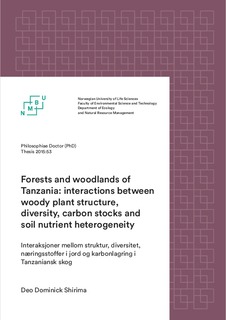Forests and woodlands of Tanzania : interactions between woody plant structure, diversity, carbon stocks and soil nutrient heterogeneity
Doctoral thesis
Permanent lenke
http://hdl.handle.net/11250/2579210Utgivelsesdato
2019-01-04Metadata
Vis full innførselSamlinger
Sammendrag
In recent years, structural components such as woody species richness, diversity, canopies and non-woody lifeforms in tropical forests and woodlands have experienced increasing rates of degradation and deforestation due to agricultural expansion and other land use changes. The decline in plant species diversity in forests and woodlands has negative effects on ecosystem processes and functions such as atmospheric carbon sequestration and mitigations of global climate changes. However, our knowledge on how varieties of structural components interacts with physiographic conditions and anthropogenic disturbances to influence ecosystem processes are limited. This knowledge gap has consequently undermined our understanding of the potential contributions of structural components in enhancing human wellbeing. This thesis consist of series of studies from a moist forest and miombo woodlands in Tanzania. The main aim was to relate structural components, such as tree species richness, canopy, carbon stocks and their interactions, with physiographic conditions, and anthropogenic disturbances. I explore (1) how do tree species richness relates to vertical heterogeneity, mean and depth specific soil nutrient availability. (2) do dominant tree species influence the richness, diversity, evenness and vertical structure heterogeneity of non-dominant tree species? (3) how do tree canopy characteristics relates to herbaceous biomass and tree species richness? (4) how do the aboveground carbon stocks of trees relate to tree species richness, diversity and evenness along gradients of physiographic conditions and anthropogenic disturbances? Using data from vegetation and soil surveys in a series of regression analyses, I showed that variation in tree species richness were better explained by mean than vertical heterogeneity in soil nutrient availability in moist forest, while in miombo woodlands, vertical heterogeneity explained a large part of the variations in tree species richness than mean soil nutrient availability. Nondominant tree species richness, Shannon diversity and evenness had negative linear and nonlinear relationships with the relative abundance of dominant tree species in wet and dry miombo woodlands. Moreover, tree species structure, physiographic conditions and anthropogenic disturbances explained over 50 % of the variations in leaf area index (LAI) and nearly 20 % of the variations in aboveground herbaceous biomass (AGBH) in moist forest and miombo woodlands. Furthermore, aboveground carbon stocks of trees were unimodal, positive or negative linearly related to tree species richness, evenness and abiotic factors in the two vegetation types. X The relationships between structural components, physiographic conditions and anthropogenic disturbances has consequences on ecosystem properties such as carbon storage and sequestration, and biodiversity. Understanding of how structural components interact with environmental conditions and anthropogenic disturbances is a step towards establishing the potential contributions of forest and woodlands to local livelihoods. Thus, management of forests and woodlands in Tanzania require strategies that maintains the existing structural complexity.
